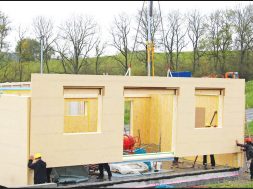Net Zero Buildings: In sync with an energy efficient future

Net Zero Buildings can reverse the excess consumption of energy attributed to the construction and building sector in India and globally, it’s time we paid attention.
As human civilization developed, the human race has had to mitigate numerous challenges pertaining to survival of its species. Now in the contemporary mode, as a race, we have new challenges to address to ensure our existence and that of future generations to come. Terms like climate change and global warming have become prevalent but the gravity of the situation needs to be understood as well. The mindless consumption of energy by humans has brought these terms into existence, therefore humans alone can resolve this issue. The construction and building sector has emerged as the primary energy consumer in India and the consumption can be significantly reduced by designing Net Zero Buildings. Designing Net Zero buildings is a necessity but the acceptance and adoption of Net Zero begins with the right attitude. Anusha Bajpai, Architect, Studio Lotus says “The first and foremost step is to ensure that the client is completely aligned with the vision of climate responsive design. For a client, Net Zero, GRIHA, LEED; these are all just labels. It is our responsibility as architects and designers to bring that awareness to them. Larger governmental bodies need to set up regulations to create awareness. But as designers, we too need to educate the general people in terms of how it can really impact their lives.”
At this point it is important to understand that Indian architecture had taken note of sustainability, net zero and green architecture long before the terms became mainstream globally Swati Gupta, Manager, GRIHA Council (West Zone) points out “Traditional Indian architecture is renowned for being sustainable. Traditionally, building design has been responsive to local requirements (climate and contextual) and is drawn from ecological knowledge. Courtyard planning, verandas as buffer spaces, use of jaalis and split level windows to optimize wind flow, chajjas and chabutras, and thermal massing are some of the passive design strategies, which are evident in any traditional building for creating comfort to the occupants. Use of natural elements like daylight, water and landscape elements also contributed to microclimate on site. Traditional architecture has not just less embodied energy because of the use of abundant local materials and local techniques and craftsmanship but also less construction waste. Water related structures like bawdi and tanks which emphasized on water neutrality of the settlements in earlier times have a special place in Indian architecture.”
While achieving Net Zero may sound like a herculean task, it is not so. Rather it’s a series of steps at work. Shabnam Bassi, Fellow and Associate Director, TERI says “Achieving true “net zero” is a journey involving a series of small steps that increasingly enhance the capabilities of our buildings and reduce the demands they place on public infrastructure. With greater awareness and sensitization major strides are being made in terms of technology that has the potential to change the way we design and operate green buildings. There are two aspects toward achieving net zero – the production and harvesting of energy and water and consumption optimization. While the generation of renewable energy can always be ramped up to meet ever increasing demand, GRIHA emphasizes operational efficiency and low / no-cost interventions to optimize demand. The same goes for water, with projects nudged toward greater efficiency in water consumption, treatment and re-use. Several government policies have come into play in recent times that encourage, incentivize and, where necessary, mandate the implementation of sustainability principles and practices in the construction sector. Once demand is set in motion, regulators can strengthen benchmarks and push for greater impact. Both manufacturers and consumers have to play the game together in order to transform the market for green buildings. The focus should always be on sensitizing consumers in order to expand the market. If we as consumers start demanding green, the market is left with no alternative but to provide it.” Apart from GRIHA another body which too has been spearheading the cause of Net Zero is IGBC (Indian Green Building Council). Responding to the existing challenges of the built environment the Green Building Movement in India is moving towards Net Zero Water, Energy, Waste and Carbon. Gurmeet Singh Arora, National Chairman, CII –IGBC says “To initiate the adoption of Net Zero Carbon concepts by the organizations at their building project level, a guidance framework has been developed by IGBC which would support the organizations to initiate GHG accounting and categorise the emissions under Scope 1, 2 & 3 at project level. Based on the inventorisation and emission intensity, appropriate emission reduction measures and abatement strategies can be developed by the organisations to ensure offset of carbon emissions. Once the inventory of GHG emissions is completed, the organisations/projects should develop a road map with short & long-term abatement strategies to fully decarbonise.”
Apart from design, the use of specific products too, help a building in achieving a net zero status. Mala Singh, Founder & MD, PEC Greening India says “Green products are available in the market, so we can set up the basic foundation of our project by using such products, it will assist us in achieving efficacy in terms of efficient use of energy, water, it will also help in reduction of waste. The Indian market has more than 3000 certified products available in the market for the construction sector, which can help us to achieve the net zero mission. Most of these products certified by the Bureau of Energy Efficiency are at least four star rated or five star rated. Apart from products, policies too need to encourage the construction of net zero buildings. The government of Maharashtra has taken note of this, the state’s policy intervention has helped us to take the green building movement to the next level. Apart from Maharashtra, other states including Uttar Pradesh, Jharkhand, Rajasthan, Madhya Pradesh and Punjab green building incentives are already in place”
50
Cookie Consent
We use cookies to personalize your experience. By continuing to visit this website you agree to our Terms & Conditions, Privacy Policy and Cookie Policy.









